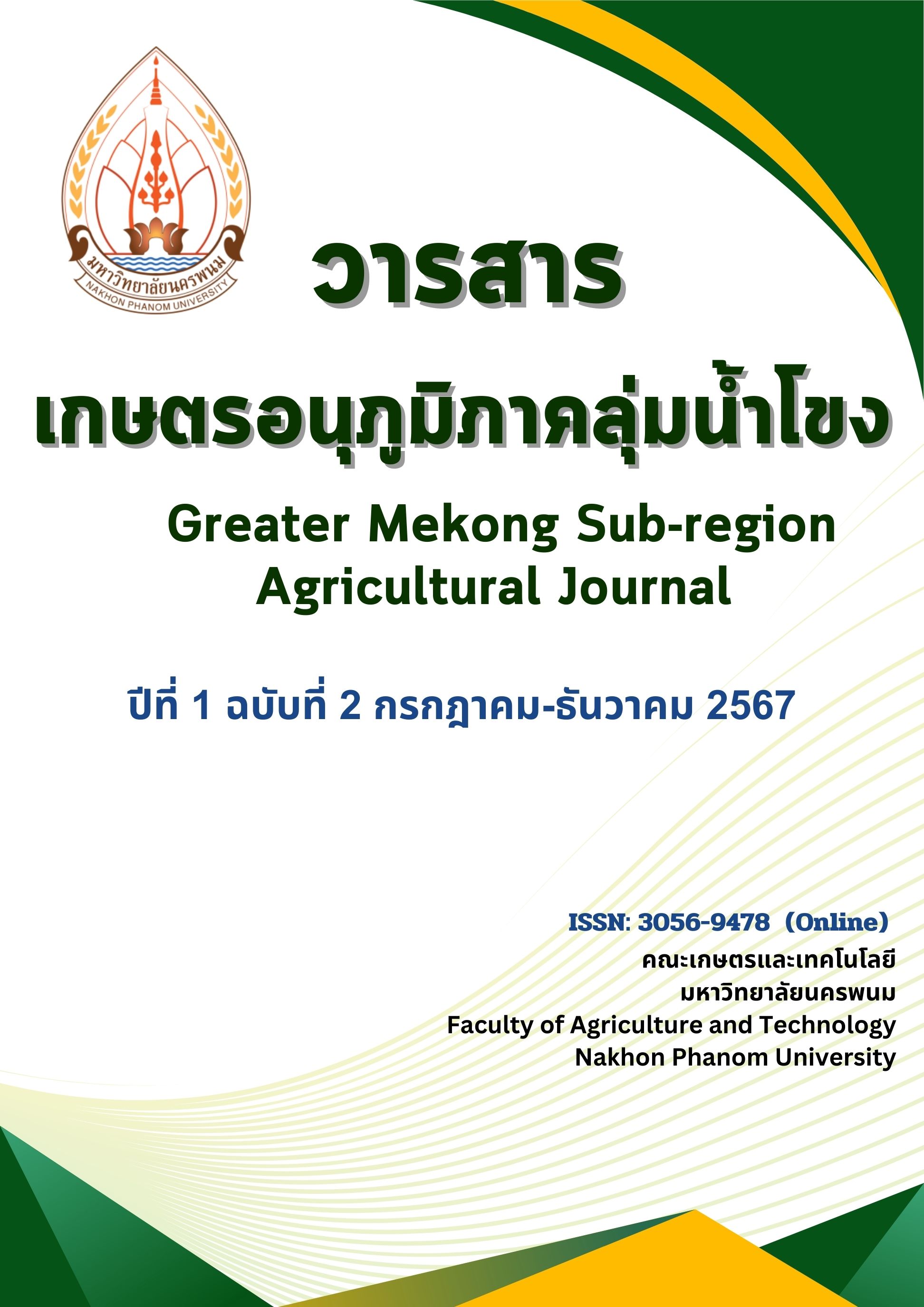Effect of nitrogen fertilizer on growth and seed size of hybrid maize grown in Wang Hai soil series
Main Article Content
Abstract
Nitrogen is a major nutrient that plays a crucial role in the growth of forage maize, particularly during the seed formation stage. It helps promote chlorophyll production, Improving the efficiency of photosynthesis in plants. This research aims to study the use of nitrogen fertilizer on the growth and seed size of hybrid maize grown in Wang Hai soil series. The experiment was conducted at the Nakhon
Sawan Field Crops Research Center in Suksamran Subdistrict, Tak Fa District, Nakhon Sawan Province. The experiment was designed as a Randomized Complete Block Design (RCBD) with 6 treatments and 4 replications. There were T1 Nitrogen control and T2 - T6 with Nitrogen fertilizer rate 5, 10, 15, 20, and 30 kg/rai. (0.5, 1.0, 1.5, 2.0, and 3.0 times of soil), respectively. The results indicated that the application of nitrogen fertilizer significantly increased the height, shelling percentage, and SCMR (Soil Chlorophyll Meter Readings) of hybrid maize compared to the control treatment without fertilizer. Furthermore, applying Nitrogen fertilizer rate 20 kg/rai. (2.0 times of soil) resulted in the highest yield weight of 100 grain seed size and economic return for the forage maize. Therefore, to achieve high yields of maize that are economically viable and to use fertilizers efficiently, it is recommended to conduct soil analysis prior to planting and to apply fertilizers at a rate of 10-5-15 (N-P2O5-K2O) kg/rai was suitable practice for hybrid maize grown in Wang Hai soil series in Wang Hai soil series.
Article Details

This work is licensed under a Creative Commons Attribution-NonCommercial-NoDerivatives 4.0 International License.
บทความลิขสิทธิ์ที่ได้รับการตรีพิมพ์เป็นลิขสิทธิ์ของวารสารเกษตรอนุภาคภูมิภาคลุ่มน้ำโขง คณะเกษตรและเทคโนโลยี มหาวิทยาลัยนครพนม
References
กิตจเมธ แจ้งศิริกุล, ศุภกาญจน์ ล้วนมณี, การิตา จงเจือกลาง, สุริพัฒน์ ไทยเทศ, ดาวรุ่ง คงเทียน และวรกานต์ ยอดชมภู. (2565). ศึกษาประสิทธิภาพการใช้ไนโตรเจนของข้าวโพดเลี้ยงสัตว์พันธุ์ลูกผสมอายุเก็บเกี่ยวยาวในกลุ่มดินเหนียว-ร่วนเหนียวสีดำ จังหวัดนครสวรรค์.กรมวิชาการเกษตร. สืบค้น วันที่ 7 ตุลาคม 2567, จาก https://www.doa.go.th/research/attachment.php?aid=2947.
กรมพัฒนาที่ดิน. (2548). ลักษณะและคุณสมบัติของ จัดทำชุดดินในพื้นที่ราบภาคเหนือและภาคกลางของประเทศไทย กระทรวงเกษตรและสหกรณ์ กรุงเทพฯ. สืบค้น วันที่ 7 ตุลาคม 2567, จาก http://oss101.ldd.go.th/web_standard/_series_desc/D_Cseries_thai.pdf.
กรมวิชาการเกษตร. (2562). เอกสารวิชาการ: การจัดการความรู้ เทคโนโลยีการผลิตข้าวโพดเลี้ยงสัตว์หลังนาในเขตพื้นที่ภาคกลาง. กรมวิชาการเกษตร กระทรวงเกษตรและสหกรณ์, กรุงเทพมหานคร. 77 หน้า
กลุ่มวิจัยปฐพีวิทยา. (2565). การใช้ปุ๋ยอย่างมีประสิทธิภาพ 4 ถูก. กองวิจัยพัฒนาปัจจัยการผลิตทางการเกษตร กรมวิชาการเกษตร. สืบค้น วันที่ 7 ตุลาคม 2567, จาก https:// www.doa.go.th/rhizobium/?p=1216.
กองวิจัยพัฒนาปัจจัยการผลิตทางการเกษตร. (2564). คำแนะนำการใช้ปุ๋ยตามค่าวิเคราะห์ดิน สำหรับพืชไร่เศรษฐกิจ. กรมวิชาการเกษตร กระทรวงเกษตรและสหกรณ์, กรุงเทพฯ.
ชูเกียรติ พระดาเวช , ณัฐพล คงดี และวันวิสาข์ ปั้นศักดิ์. (2560). ผลของระยะเวลาการใส่ปุ๋ยไนโตรเจนต่อการเจริญเติบโตและผลผลิตของข้าวโพด. ในการประชุมวิชาการดินและปุ๋ยแห่งชาติ ครั้งที่ 5 ณ โรงแรมเซ็นทรา บาย เซ็นทารา แจ้งวัฒนะ กรุงเทพฯ น.110-118.
ธีระศักดิ์ สาขามุละ และบุญมี ศิริ. (2554). ผลของขนาดเมล็ดต่อความงอกและการเจริญเติบโตของต้นกล้าข้าวโพด. แก่นเกษตร 39:98-103.
บุปผา โตภาคงาม. (2549). ดินเค็มภาคตะวันออกเฉียงเหนือ. ขอนแก่น: ภาควิชาทรัพยากรที่ดินและสิ่งแวดล้อม คณะเกษตรศาสตร์ มหาวิทยาลัยขอนแก่น.
ประเสริฐ สองเมือง. (2543). การใช้ปุ๋ยอินทรีย์ในนาข้าว. กลุ่มงานวิจัยความอุดมสมบูรณ์ของดิน และปุ๋ยข้าวและธัญพืชเมืองหนาว กรุงเทพฯ: กองปฐพีวิทยา กรมวิชาการเกษตร.
พิทยา สรวมศิริ. (2554). ธาตุอาหารในการผลิตพืชสวน.ภาควิชาพืชศาสตร์และทรัพยากรธรรมชาติ คณะเกษตรศาสตร์มหาวิทยาลัยเชียงใหม่. จังหวัดเชียงใหม่.
พรทิวา คล้ายเดช. (2557). การเปรียบเทียบผลของการใช้ปุ๋ยสูตรต่าง ๆ เพื่อเพิ่มผลผลิตข้าวโพดเลี้ยงสัตว์. วิทยานิพนธ์ปริญญาโท, มหาวิทยาลัยสุโขทัยธรรมาธิราช.
สงวนศักดิ์ ธนาพรพูนพงษ์, จักรกฤษณ์ ขันทอง, และสุชาดา เวียรศิลป์. (2544). ผลของขนาดเมล็ดที่มีต่อคุณภาพเมล็ด พันธุ ์ข้าวโพด. รายงานฉบับสมบูรณ์โครงการวิจัย ภาควิชา พืชไร่ คณะเกษตรศาสตร์ มหาวิทยาลัยเชียงใหม่, เชียงใหม่.
ยงยุทธ โอสถสภา, อรรถศิษฐ์ วงศ์มณีโรจน์ และ ชวลิต ฮงประยูร. (2554). ปุ๋ยเพื่อการเกษตรยั่งยืน, พิมพ์ครั้งที่ 2, สำนักพิมพ์มหาวิทยาลัยเกษตรศาสตร์, กรุงเทพฯ, 519 น.
สืบสกุล ศิริยุทธ์ และ ศักดิ์ดา จงแก้ววัฒนา. (2554). การประเมินระดับคลอโรฟิลล์ในใบข้าวโพดโดยการใช้ Chlorophyll meter และความสัมพันธ์กับน้ำหนักแห้งมวลชีวภาพและผลผลิต. แก่นเกษตร. 39 (ฉบับพิเศษ): 166-175.
สำนักงานเศรษฐกิจการเกษตร. (2566). สถานการณ์สินค้าเกษตรที่สำคัญและแนวโน้มปี 2566. สืบค้น วันที่ 1 ตุลาคม 2567, จากhttps://impexpth.oae.go.th/import.
อนนท์ จันทร์เกตุ, พีรวัฒน์ พิพิธกุล, ธนารักษ์ แสงทอง, ภาษิตา ทุ่นศิริ, ปรเมศ บรรเทิง, รัตนจิรา รัตนประเสริฐ และนทีทิพย์ สวัสดิ์รักษา. (2567). ประสิทธิภาพการใช้ปุ๋ยไนโตรเจนการเจริญเติบโตและผลผลิตของมันสําปะหลัง 2 พันธุ์ที่มีลักษณะการแตกกิ่งต่างกันที่ปลูกภายใต้การให้น้ำเสริม. แก่นเกษตร 52 ฉบับที่ 1: 101-114 (2567)./doi:10.14456/kaj.2024.8
Alngiemshy, N. F., Alkharafi, J. S., Alharbi, N. S., & Al-Sowayan, N. S. (2020). Effect of seed size on germination of faba bean plant. Agriculture Sciences, 11, 465-471.
Arunah U.L., E. B. Amans., M. Mahmud; A. Ahmed; G.L. Luka., A. S. Isah., B.A. Babaji and E.C. Odion. (2014). Yield and yield components of maize as influenced by row arrangement, nitrogen and phosphorus levels in maize (Zea mays L)/ castor (Ricinus communis) mixture. IOSR Journal of Agriculture and Veterinary Science. 7:45-49.
Back, G. R., and K. H. Hartge. (1986). Bulk density. pp. 363-375. In: A. Klute, Ed. Methods of soil analysis. Part 1, Agronomy No.9, 2 nd ed. American Society of Agronomy, Madison, WI.
Black, C.A. (1965). Method of soil analysis. Part A. Agronomy 9. American Society of Agronomy Madison, Wisconsin.
Baysah, S. N., Olympio, N. S., & Asibuo, J. Y. (2018). Influence of seed size on the germination of four cowpeas (vigna unguicula (L) Walp) varieties. ISABB Journal of Food and Agricultural Sciences, 8(4), 25-29.
Cottenie, A. (1980). Soil and Plant Testing as a Basis of Fertilizer Recommendations. FAO Soil Bulletin 38/2. Food and Agriculture Organization of the United Nations, Rome.
Gardner, W. H. (1982). Water content. Chapter 21 in Klute, A., ed. Methods of soil analysis. Part 1. Physical and mineralogical methods. 2nd Ed. Soil Science Society of America, Inc. Madison, Wisconsin
Jackson, M.L. (1960). Soil Chemical Analysis. Englewood Cliff, New Jersy, 183-190.
Pervaiz, Z., Hussain K., Kazmi S.S.H. and Gill K.H. (2004). Agronomic efficiency of different N:P ratios in rain fed wheat. International Journal of Agriculture and Biology. 6(3): 455–457.
Walkley, A., and I.A. Black. (1934). An examination of the degtjareff method for determining soil organic matter and a proposed modification of the chromic acid titration method for determination of soil organic matter. Soil Science. 37: 29 – 33.


